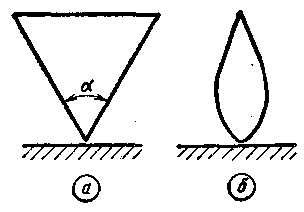Received among the Amateurs widespread vertical antenna type "Ground Plane" does not have sufficient broadband and no additional tuning can be applied to work only in a narrow band of frequencies. The so-called "thick" vertical antenna radiating surface which has a variety of forms, is free from this drawback and satisfactorily operate in the frequency range with overlap factor up to 3.
The most widely conical (Fig.1,a) and exponential (Fig.1,b) of the antenna. The impedance of the conical antenna is constant along its length and depends on the angle a at the apex of the cone. Broadband properties of the antenna increases with increasing a and reach the optimum with a=60-70°; in this case, the impedance of the antenna is approximately 70-80 Ohm.

Fig.1
Exponential antenna, the impedance of which increases along its length approximately exponentially, has the same broadband properties, as well as tapered. At the same time exponential antenna has the great advantage of its maximum diameter is 3 times less than that of the conical.
For high range is almost not possible to realize an antenna with a continuous radiating surface in the form of figures depicted in Fig.1. Such antennas are made of tubes or wires. For exponential antennas, in addition, a smooth envelope replace broken.
On the radio UW4HW used exponential antenna on bands 14, 21 and 28 MHz, the construction of which is shown in Fig. 2. Radiating antenna system is formed by six wires arranged in vertical planes at an angle of 60° to one another.

Fig.2
At the base and at the top of the antenna wire are electrically connected together and with the help of insulators mounted on the mast carrier. The latter is made of three equal-length pipe sections connected by insulating inserts. As a supporting mast, you can also use a wooden pole. The antenna shape is provided by the struts fixed to one-third the total height of the antenna. Each strut ends insulator through which the wire antenna. If necessary, you can refuse to install the spacers and secure the shape of the antenna with spreaders attached to the wires at the points of inflection with the use of insulators. In this case, if the mast has a sufficient rigidity, it is possible to do without additional stretch marks.
Antenna power is carried out using a coaxial cable with a characteristic impedance of 75 ohms. The Central conductor is connected to the bottom of the antenna and the shielding braid to a good earth ground when mounting the antenna directly on the ground or to an artificial earth if the antenna is mounted on the roof of the house. Artificial land can serve as a metal roof or six horizontal wires radiating from the base of the antenna. Wire artificial lands are located in the same vertical planes with the respective radiating antenna wires and have a length equal to the length of the radiating wires.
Antenna and artificial ground is made of copper wire with a diameter of 1.5 mm. Practically measured SWR at the frequency range of 14.0 to 29.7 MHz are in the range 1.2 to 1.9. Calculating the size of the antenna for other bands are easy to produce, specifying the length of the wire antenna in the range (0,24-0,28)l min and the angle a at the base of the antenna in the range of 60-70°.
Experience in the use of the described antenna shows that it outperforms the antenna type "Ground Plane" and its ease of design can be used successfully in Amateur practice.
Author: Yu Matiychenko (UW4HW); Publication: N. Bolshakov, rf.atnn.ru






